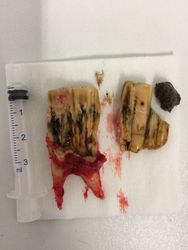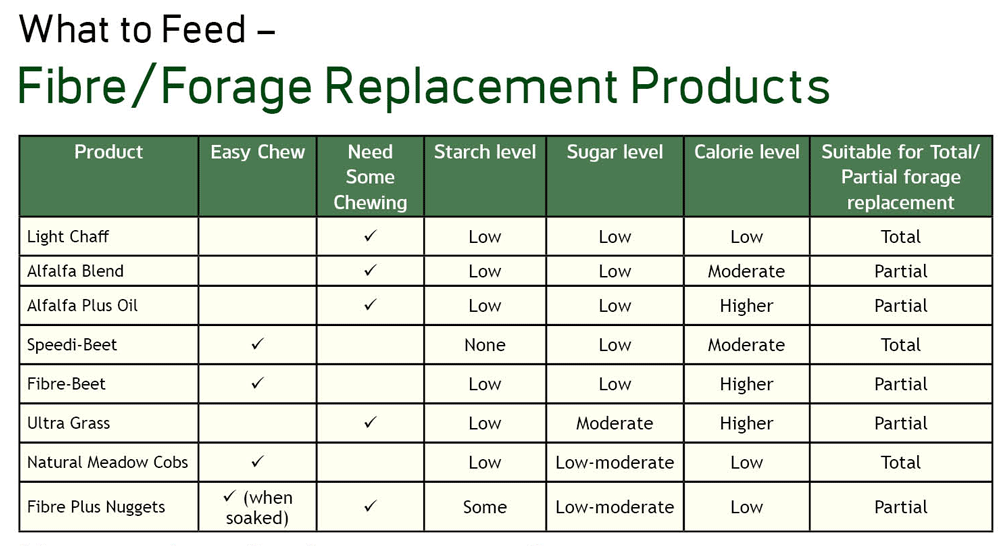Dental Problems - Diet Management

Download this article as a PDF
Poor dentition is not just a problem for older horses and those who suffer may be prone to weight loss as well as being at increased risk of problems, like choke or colic.
Dental Conformation
Horses have 12 premolars and 12 molars (cheek teeth), split into four groups of 6, in each side of the top jaw and bottom jaw, and each group of 6 should function as one grinding unit. They are very closely packed together and the front and back tooth of each row are angled slightly so that they keep the other teeth tight together.
Signs of dental issues:
- Quidding (dropping semi-chewed balls of feed/forage)
- Eating slowly
- Eating less forage
- Hunger/anorexia
- Hollow flanks and tucked up appearance
- Bad breath
- Excessive saliva production
- Progressive weight loss
- Loose droppings
- Long fibre in the droppings (generally, fibre in droppings should be shorter than 1.5cm)
Common Problems:
Diastemas (gaps)

A diastema is a gap between adjacent teeth and there are two basic types:
Open - one that is the same width at the top and the bottom.
Valve – one that has a narrow opening at the top and a bigger gap at gum level.
Valve diastemas are more likely to cause problems because food material gets compressed and stuck, in the gap, and, as it starts to ferment and break down, causes an infection in the gum, which can be extremely painful for the horse, if left untreated.
Feeding Aims
Reduce the amount of long fibre forage and offer alternatives which are easier to chew. Maximise turnout time to try to meet fibre requirements with grass as much as possible.
Fibre Products – choose Easy Chew
Compound Feed – choose Easy Chew
Caries (cavities/tooth decay)

This is the scientific term for tooth decay or cavities and occurs when specific types of bacteria turn sugar and carbohydrates (starches), in feed, into acids which dissolve minerals in the hard enamel that covers the tooth causing it to erode or develop pits and can eventually reach the inner dentine. There are two types:
Peripheral – involve the non-grinding surface of the tooth.
Infundibular – involve the grinding surface.
Feeding Aims
Reduce the starch and sugar content of the diet, including forage. The horse should still be encouraged to chew as much as possible to produce saliva, which helps neutralise acid in the mouth and stomach. Choose hay over haylage and be wary of some dried grass products and cubes as these may be naturally higher in sugar.
Fibre Products – choose Low Starch/Sugar and Need Some Chewing
Compound Feed – choose Low Starch/Sugar
Fractures/damaged teeth – including extractions

A fractured tooth can be painful, especially if infection sets in, so can result in quidding and bad breath as well as anorexia, weight loss and food impaction. Occasionally, infection from the fractured tooth can reach the supporting bones and sinuses.
Feeding Aims
Chewing should be kept to a minimum to help avoid food getting packed into fractured/damaged teeth during the immediate treatment period.
Fibre Products – choose Easy Chew/Total Forage Replacement
Compound Feed – choose Easy Chew
Old Age/Poor Dentition
Loss of teeth or poor tooth condition in older horses can affect their ability to chew, which could result in partially digested food causing blockages in the gut as well as increasing the risk of other digestive upsets.
Feeding Aims
Maintaining fibre intake and condition by adjusting the diet according to how well the horse can chew. Conditions, like Cushing’s Disease (PPID), will also need to be taken in to consideration (for PPID, a low starch diet is indicated).
What to Feed - Forage/Fibre Alternatives
Maintaining fibre intake is essential for a healthy gut and to satisfy the horse’s need to chew/eat for the majority of the day. Options are available to totally or partially replace the long fibre forage in the diet.
Partial Forage Replacement
For those with milder dental issues who are consuming some long fibre (hay/haylage), it may only be necessary to offer fibre alternatives to partly replace the forage portion of the ration.
Total Forage Replacement
Total forage replacement is suitable for those that can no longer safely manage long fibre. Pasture can often be managed for a longer period than hay and haylage, providing there are no problems with the incisors.
- For those horses who need to control starch and sugar intake, check the labels and look for unmolassed products.
- Most “fibre feeds” and forage replacers are not fortified with vitamins and minerals so can be fed safely alongside the horse’s current bucket feed without causing an imbalance in mineral intake
- Soaked or easily water-softened products can be beneficial to increase moisture intake, which may help counteract some of the risks of gut function compromise
- Where possible, you should provide a combination of two or three fibre alternatives to add variety, particularly for those stabled more. These can be mixed together and/or fed separately.
- If the horse can manage a suitable chaff, always feed one as it will occupy the horse for longer than a soaked feed or cube.
- Feed forage replacers/fibre alternatives separate from the horse’s compound feed.
- Splitting the fibre replacement offered into a number of buckets, spread around the stable or paddock, will encourage natural foraging behaviour, slow down eating and occupy the horse for longer.

How much to feed
The total forage and concentrate ration should weigh the equivalent of 1.5 to 2.5% of bodyweight, depending on workload and whether you are looking to achieve weight loss (1.5%), weight gain (2.5%) or to maintain the current condition (2%). You will know how much concentrate you are giving so you then need to work out how much forage your horse is actually consuming.
For example, for a 500kg horse at rest, aiming to maintain the current weight and condition needs 2% of 500kg = 10kg (dry weight) per day.
Hay/Haylage
Do this by weighing the hay/haylage you give each day then weighing what is left each day so that you can calculate what has been eaten.
Grazing
You can use a relatively crude method of estimating grass intake, depending on turnout time. For example, if a 500kg horse is grazing for 6 hours (0.25 of a day), we would calculate the intake (2%) multiplied by the bodyweight then multiplied by the time spent grazing - 0.25 (2% x 500) = 2.5 kg of grass dry matter.
The amount of forage replacement product to feed is calculated on a (dry) weight for weight basis. So, for our 500kg horse requiring a total ration (forage + concentrate (compound feed)) of 10kg per day:
10kg – (total forage actually consumed + concentrate (compound feed) ration) = Forage replacement kg
What to Feed – Compound Feeds/Balancers
Choose according to the horse’s calorie requirements ie. workload and whether it needs help maintaining condition or is a naturally good-doer.
- Recommended feeding amounts for soaked feeds refer to the dry weight. Always measure/weigh before soaking.
- Feed separately from the horse’s forage replacer/fibre alternative.
- Divide both compound and forage feeds into as many small meals as possible, spread throughout the day.
- Balancers are ideal as the sole concentrate, for good-doers, or can be fed with significant amounts of Speedi- or Fibre-Beet, or with wet Cooked Cereal Meal, to provide additional calories.
- A prebiotic supplement, like Digest Plus, may be advisable, especially after a course of antibiotics.



